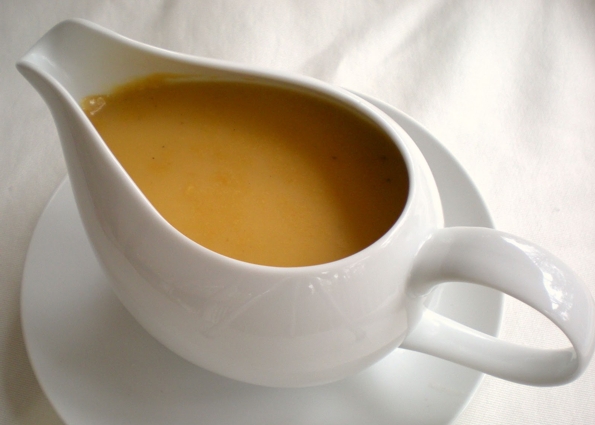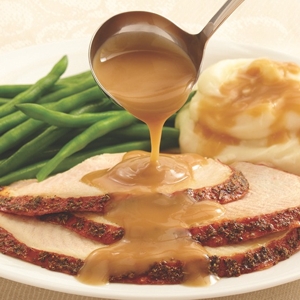It is the scourge of Sunday suppers, the Frankenstein of festive feasts. I refer, of course, to lumpy Gravy. All family cooks have had it at one time or another. But there’s no need to ever suffer this embarrassment again – if you know the fundamental rules of Sauce making…
 Follow my rules and you’ll get perfect Gravy every time!
Follow my rules and you’ll get perfect Gravy every time!
With Christmas coming on apace and plans for the family festive feast in full swing, I thought it would be a good time to review some of the basics of Sauce making, at least as it relates to gravies and their like. ‘Tis the season I get a lot of requests for a refresher on this topic.
The basic ingredients
Gravy has just 2 basic ingredients: Pan Drippings and about 2 tbsp. / 30 ml Flour. But to make it a truly great Sauce and get the most out of your pan, you’ll also need a Deglazing Liquid, a little cold Water, and Salt and Pepper to balance the seasoning.
What do these ingredients do?
The Pan Drippings furnish the colour and flavour that makes your Gravy what it is destined to become. They are precious, and should be carefully preserved after removing the Meat from the Roasting Pan.
The Flour is what actually thickens the Gravy, of course. It is a raw starch which absorbs water and blends with the Drippings to thicken the mixture. But it’s essential to follow the classic Slurry technique to ensure you get smooth, velvety Gravy every time. You can experiment with the amount of Flour you use depending on how thick you want your gravy. Just remember, a little goes a long way! If you prefer a translucent, shiny ‘glaze’ style gravy, use Corn Starch in place of Flour. You might also want to experiment with other powdered Starches such as Potato Flour and Arrowroot.
The Deglazing Liquid may be a little Apple Juice, a splash of White Wine or any acidic liquid with a flavour complementary to the Meat your Drippings come from.
The Cold Water (or Wine or Juice, or whatever you like, as long as it is cold) is for dissolving the Flour prior to adding it to the Pan; 1/3 cup / 85 ml should do just fine. Dissolving the Four in a Cold Liquid ensures it won’t lump.
Salt and Pepper. You may find that you need to add Salt or Pepper to your finished Gravy to balance the flavour, especially when using the Pan Drippings from something as delicate as Chicken, which is relatively lightly flavoured.
What you do
First, pour off any excess Fat from the pan. Be sure not to lose any of the actual Juices. I have a gadget called a Gravy Separator. It looks like a regular 4 cup / 1 L measuring cup but has a spout that lets you pour off the Juice from under the Fat. (When you pour Fat, Juice and all into the this wonder mug, the fat comes to the top with the clear juice below.)
If you’ve used the Separator, add the Juice back to the pan and toss in that Deglazing Liquid. The acid helps the beautiful brown flavour and colour from the bottom of the Pan loosen off and blend with the Juice. Stir vigourously over medium heat until all the good stuff has lifted off the bottom of the pan.
Now, dissolve the Flour in the Cold Liquid beating with a fork. Once the flour is all dissolved, and there are no lumps present, you are ready to make thickening magic.
Add the Flour mixture to the Pan (which should still be on medium heat) and stir constantly for a couple of minutes while the Drippings and the Flour ‘slurry’ blend and embrace one another.
After about three minutes, you should have a beautiful, rich Gravy with absolutely no lumps. The key to being lump-free is to dissolve the Flour completely in the Cold Liquid first. This is an ancient French method which is a close cousin to the Roux technique. There, you cook Flour and Butter (in equal amounts by weight) in a sauce pan until you get a smooth velvety mixture. Then add whatever liquid you want to thicken and stir for a few moments until done. You can cook your Roux longer, browning it as you go, if you want a Brown Sauce.
Finally, allow the Gravy to simmer for 15 minutes or so. This allows the Flour to cook off so your Gravy won’t taste ‘pasty’.
You should make your gravy before loading all your other menu items into serving bowls and assembling everything on the dining table. This way your Gravy just naturally gets the simmering time it needs to cook the Flour and develop its full flavour.
What if I still get lumps?
That’s what sieves are for! Just sieve out the lumps and let the remaining gravy simmer to its heart’s content.
There is no such thing as a Gravy disaster; only cooks who don’t know how to save a batch of rogue Sauce!
~ Maggie J.

